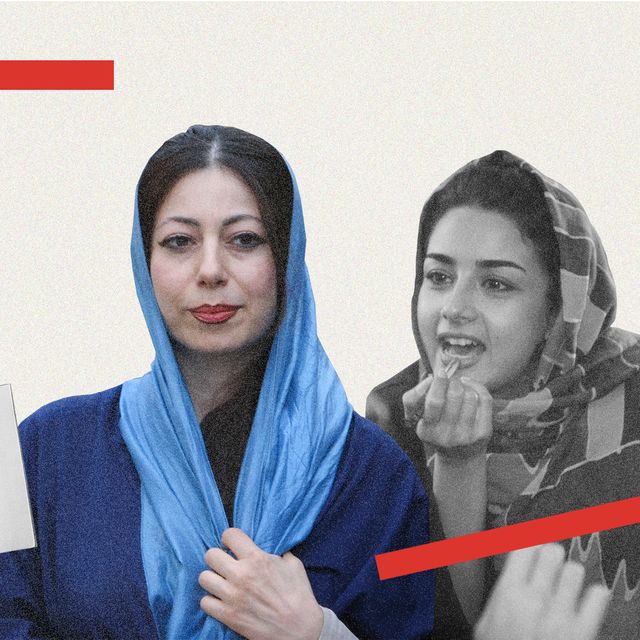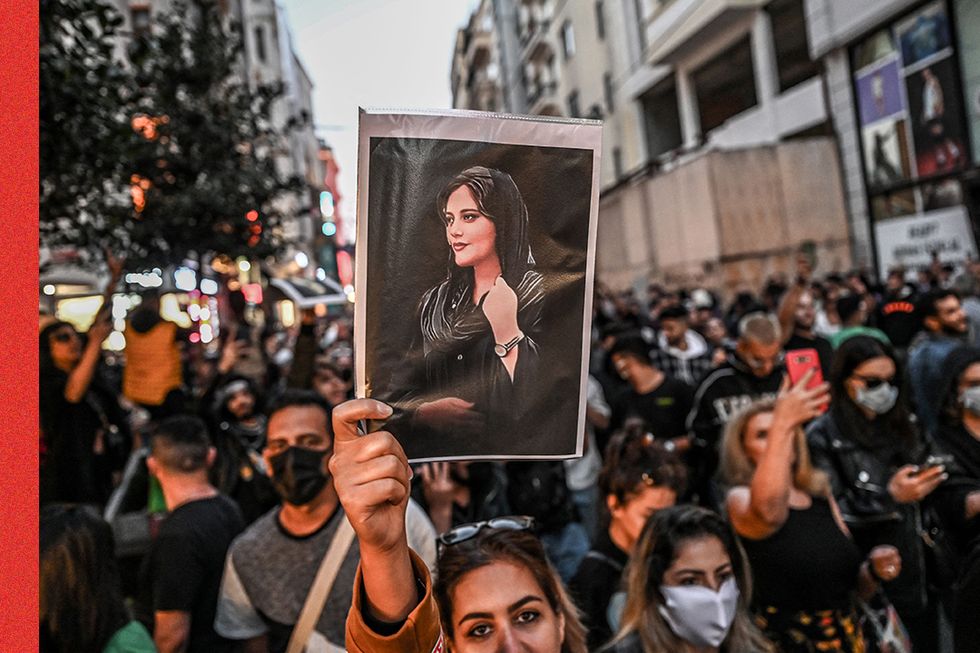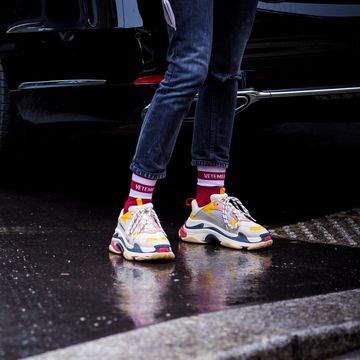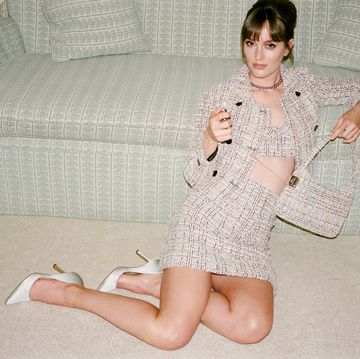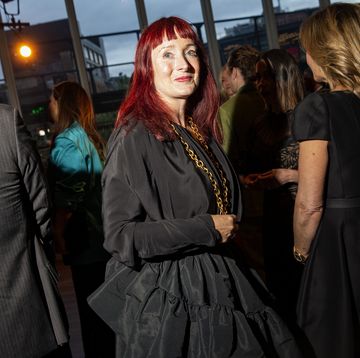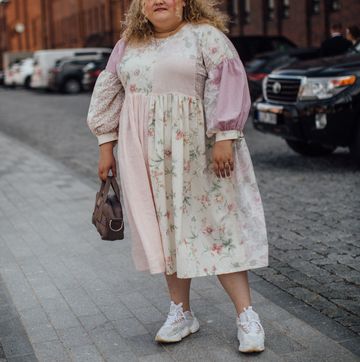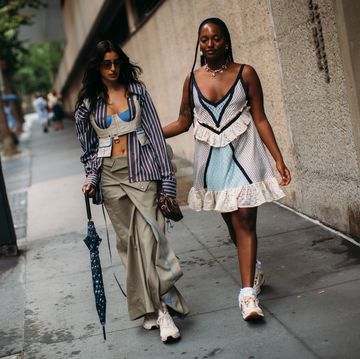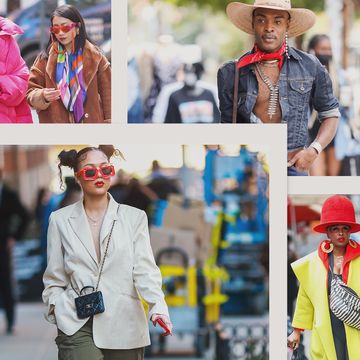When Mahsa Amini, a 22-year-old Kurdish woman, stepped off the train this past September for her vacation in Tehran, she wore a loose, black chiffon headscarf with five strands of hair showing. The hair was a statement—the five strands symbolizing bold defiance of the regime, en route to a removal of the headscarf altogether. She chose a deep red gloss to cover her lips, a decision that seemed to foreshadow the bloodshed that came next. Within minutes, she was taken aside by the Guidance Patrol, the morality police of the Islamic Republic of Iran, and beaten within inches of her life. Charged with immoral dress and appearance, she died in custody shortly thereafter.
For months, the world has watched as Amini’s death spurred an outpouring of resistance on the streets of Iran, with protesters communicating their politics through fashion, and, in many cases, being punished for it. Hundreds have died in the ongoing protests connected to headscarf laws and dress codes. But as protests intensified last month, news emerged that government officials are considering changing the law.
Amini’s story is not unique. Nor is it new. For decades, fashion, style, and makeup choices have been dictated by the country’s strict laws. The Islamist Regime—which came to power during the Iranian Revolution of 1979—wields its authority by regulating public dress and appearance, mandating austerity through attire. Women are to be cloaked in loose, preferably black fabrics that cover them from head to toe. No hair or ears should show; the headscarf should be so tightly wound that it reveals only the oval part of the face. No makeup or eye-catching accessories are permitted.
Protesters defy these laws in myriad ways; most recently, by cutting their hair in solidarity with fellow Iranians. (Eye-catching hairstyles for men or hair peeking out of headscarves for women could be cause for arrest and public flogging.) Each sartorial choice can become a battleground for politics. Each display of attire a possibly punishable offense.
Navigating the Changing Politics of Beauty
There is a long history of fashion intertwining with power and rule in Iran, dating back to the Qajar dynasty, which ruled Iran from 1789 to 1925. In the 19th century, paintings depicting male and female beauty were remarkably similar, with oval faces and moon-shaped, kohl-lined eyes, heavy eyebrows joining in the middle, and hair framing the face. Men appeared beardless, sometimes with mustaches—women too. Beauty was explored through face, body, and the choice of outerwear, which in the 19th century included baggy harem pants and tunics for both men and women. Both sexes embraced the same styles, playing with gender on both sides—the politics of which were understood and explored through ideals of beauty. Supporters of the dynasty chose a similar aesthetic and expressed their politics with their style choices.
Each successive ruling party in Iran changed fashion to align with their political point of view. And as each ruler came to power articulating their style, so, too, did a subculture that spoke back to those in power through oppositional wares.
For example, when the Pahlavi family re-emerged as monarchs in the 1960s and 1970s, they signaled their alignment with the West by favoring Western trends. Royals and their supporters wore haute couture, fresh from the runways of Paris and Milan, as they walked the streets of urban centers throughout the country. Yves Saint Laurent was pleasantly surprised to see his miniskirt designs featured in Iran before they were embraced in the U.S. Imported Western chic was the currency of royalists. Hair and makeup for both men and women followed.
But an emerging class of dissidents saw these choices as evidence of a corrupt regime, corroding the moral order of a country by becoming “Westoxicated,” or overly fascinated by the West. Long legs emerging from tweed miniskirts or short caftans were seen as unacceptable. So were the eye-catching painted designs of blue and green eyeshadow that highlighted their faces.
To express their resistance, the Islamists encouraged women to don the chador, a black cloak covering their bodies. Men were told to cover their faces in beards. And Oxford shirts that featured ties were criticized as “too Western.” Instead, rounded collars and heavy linen robes in muted colors were seen as symbols of Islamist resistance.
When the Islamists were victorious in ousting the Shah, they ran on a platform of re-claiming Iran for Iranians, and their platform would be executed by regulating modesty and dress. In the early 1980s, as Ayatollah Khomeini ushered an Islamist regime into power, the hijab became the mandatory dress code for women.
Decoding Protest Attire
Now, the Iranian people are once again using their style to speak their minds. To clap back at a regime that they had disagreed with for the past four decades, fashion has been their means of communication with each other and to the brutal Islamists in power.
It began in the late 1980s with the headscarf sliding back one millimeter at a time, earning the movement the nickname the “Millimeter Revolution.” The more strands of hair pulled forward, the more revolutionary the individual. If the hair was dyed, even bolder. And high fashion was reserved for indoors—house parties, raves, or underground concerts. Women walked inside and promptly threw off their black shrouds, revealing glittering nightgowns or even haute couture.
Slowly, by the late 1990s, brightly colored headscarves and form-fitting coats replaced the black chador. Bodies were still covered, technically, but Islamic outerwear became in vogue. Women played with colors—white or red was revolutionary. They played with form—the more structured or tight-fitting the aforementioned cloak, the more fervent the resistor. Red lipstick and heavily made-up eyes became de rigueur.
In the summer of 2004, thousands of women organized en masse to appear in the streets of Tehran in open-toed shoes with red shellacked polish on their hands and toes. They reasoned that the punishment—purportedly hands dipped in cockroaches and feet covered with insects—could not possibly be executed on thousands of women at once. If they all appeared on the same day, there were not enough cockroaches in all of Iran to arrest more than one hundred women at once. They were correct. The first several dozen met this fate. But the regime was outnumbered and, it appeared, outsandaled. After July 2004, open-toed shoes were deemed legal.
Looking Toward the Future
Fashion in Iran is not just about looking good. Because the mere removal of a headscarf could earn a woman a deadly beating, as Amini showed us, it is indeed a revolutionary act. The more eye-catching the appearance, the more women and male allies in the resistance communicate their irreverence to the regime. The byproduct is a gradual chipping away at the power of the regime through style—and right now, it seems to be working. Take, for instance, the abolishment of the morality police and potential changes to the mandatory hijab law. It may be a small step, but it’s something. One can’t help but think that a giant leap is necessary, and long overdue.
